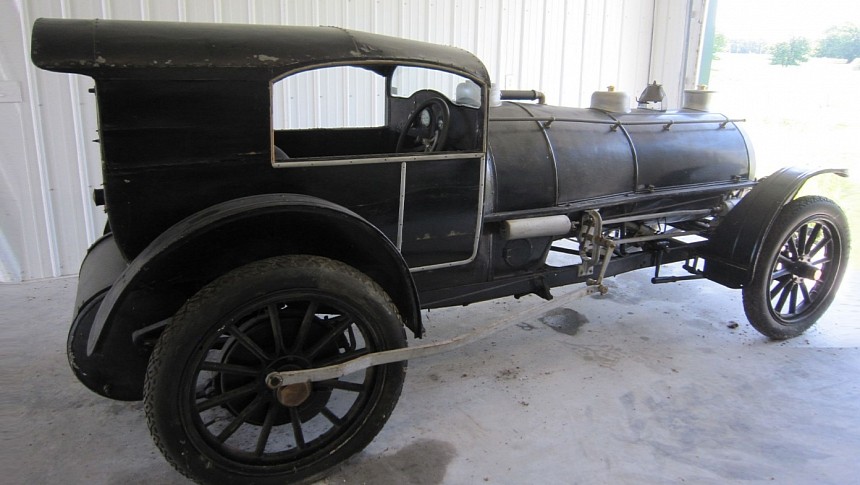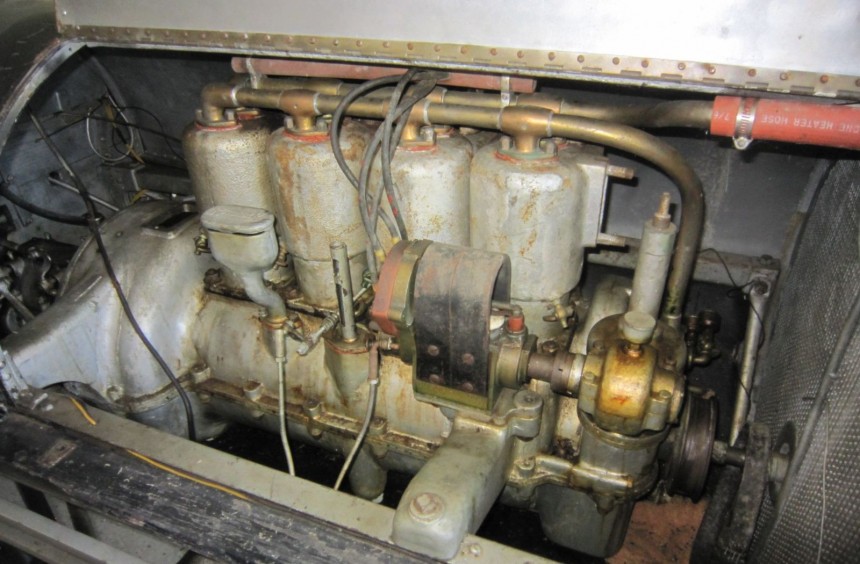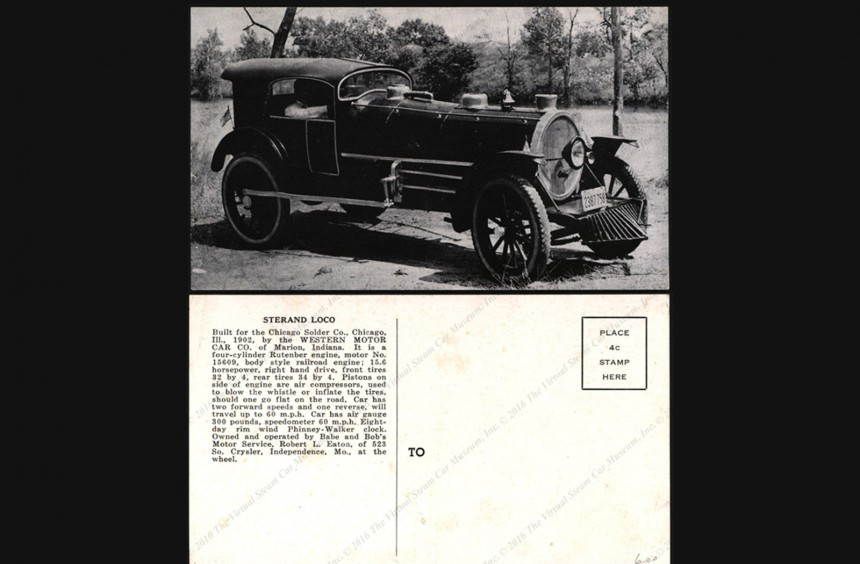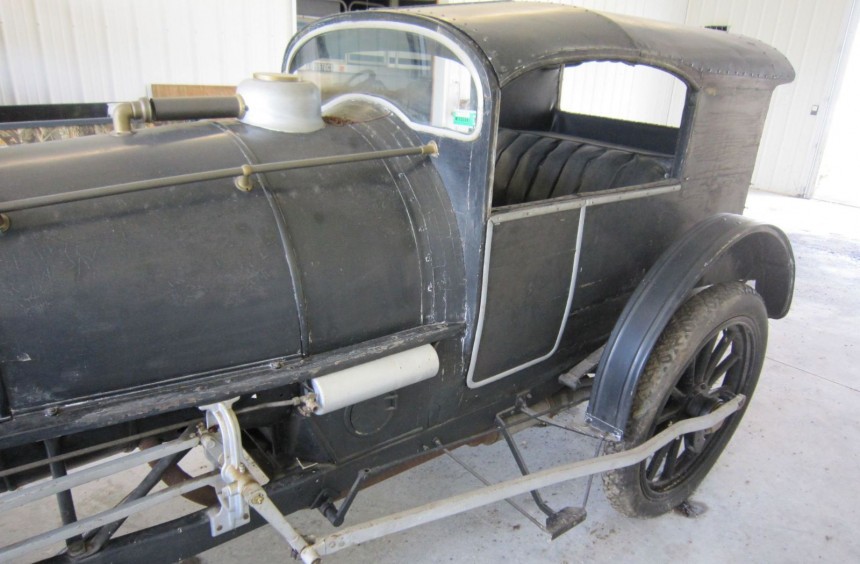Built during an era when the American West was still relatively wild, the Sterand Loco was one of the first bespoke promotional cars in the world.
When I hear "promotional cars," the first vehicles that come to mind are Red Bull's modified Minis that roamed the roads during the second half of the 2000s with a massive can of the company's famous energy drink on top.
But, the concept of a wacky-looking custom vehicle built to promote a product or a service goes way back. Some of the most iconic, like Oscar Wiener's Wienermobile, GM's Futurliner, or Zippo's custom Chrysler New Yorker, were developed during the 1930s and 1940s.
Recently, we discovered one that's even older but just as wacky and fascinating. Built in the US in 1902, this incredible one-off that survived and resurfaced a few months ago is called Sterand Loco. Yes, it does look pretty loco even 121 years after it hit the streets, but its name doesn't come from the Spanish word for crazy, but from its resemblance to a steam-powered locomotive.
Though the Loco isn't as iconic as the aforementioned promotional vehicles and information about it is scarce, a plaque on its bodywork and an engraving on the engine block tell us it was built by the Western Motor Car Company of Marion, Indiana, a business formerly known as Rutenber Manufacturing Company.
Founded in 1898 in Chicago, Illinois, by a bright young man named Edwin Rutenber, the company built internal combustion engines for many of America's early carmakers. Rutenber was both a businessman and an inventor who developed a single-cylinder engine, then went on to create some of the first four- and six-cylinders built in the US.
In 1902, when the Loco was developed, Rutenber relocated his company to Indiana and renamed it Western Motor Car Company. Three years later, a Stoddard-Dayton car equipped with a Rutenber engine won the first-ever race held at the Indianapolis Motor Speedway. The business was renamed again in 1912 into The Rutenber Motor Company and ceased operations around 1933.
Apart from its revered Rutenber engines, the Western Motor Car Company also briefly ventured into the car manufacturing business. According to multiple sources, less than a dozen vehicles came out of its Indiana factory, and one of the first was the Sterand Loco.
As I mentioned before, information about this car is scarce. The only surviving document that sheds some light on this unconventional ride is the postcard above, sourced from the Virtual Steam Car Museum. It features a picture of the vehicle on the front, while valuable information about it is written on the back.
It was a custom-built promotional vehicle commissioned by the Chicago Solder Company, a business that made flux-cored solder used in the electric industry.
Its bodywork was fabricated to resemble a steam-powered locomotive, boasting features like a single, locomotive-derived headlight, a steam stack, a sand dome, and a cowcatcher. However, a Rutenber inline-four was hidden inside its faux boiler. The engine used an inlet-over-exhaust design which was common during that period, and, according to the postcard, it could make 15.6 hp.
What made this engine particularly fascinating was the built-in air compressor that operated the locomotive-inspired steam whistle and inflated the tires in case of a flat. A feature now common in vehicles like 4x4s, the built-in air compressor was an innovation back in 1902, and the Loco appears to be the first car to utilize it.
In addition to the innovative engine, the Loco came with a two-speed manual transmission (plus reverse), a spartan cabin with two seats, a steering wheel curiously mounted on the right side, and drive rods connected to the rear wheels. These rods were actually functional, moving along with the vehicle and accentuating its locomotive-inspired look.
Another interesting fact about this wacky ride is its top speed. According to the same postcard and its speedometer, it could reach a top speed of 60 mph (96.5 kph). This might not sound like much today, but back in the early-1900s, it was an impressive figure. To put it into perspective, Ford's famous Model T, introduced five years after the Loco, could only achieve a top speed of 40–45 mph (65–70 kph).
Yes, it's possible that this figure was part of the Loco's marketing campaign, but considering it's still around today, it might be tested one day.
The unusual promotional vehicle poped-up on the Lost N the 50s Classic Cars website a few months ago. It's currently listed for sale, and those interested in acquiring it must pay $260,000 to become its fourth owner.
As you can see in the images, it's not in good shape, even though it has only 12,000 miles (19,312 km) on the odometer. Despite that, it has all its original parts, and with some dedicated restoration work, the Loco can be brought back to its former glory.
Whether or not it's worth a quarter of a million is debatable, but without a doubt, it's one of the most intriguing classic vehicles we've seen in a long time, and it might just be the first promotional car ever built in the United States.
But, the concept of a wacky-looking custom vehicle built to promote a product or a service goes way back. Some of the most iconic, like Oscar Wiener's Wienermobile, GM's Futurliner, or Zippo's custom Chrysler New Yorker, were developed during the 1930s and 1940s.
Recently, we discovered one that's even older but just as wacky and fascinating. Built in the US in 1902, this incredible one-off that survived and resurfaced a few months ago is called Sterand Loco. Yes, it does look pretty loco even 121 years after it hit the streets, but its name doesn't come from the Spanish word for crazy, but from its resemblance to a steam-powered locomotive.
Built by a pioneer of internal combustion engines
Founded in 1898 in Chicago, Illinois, by a bright young man named Edwin Rutenber, the company built internal combustion engines for many of America's early carmakers. Rutenber was both a businessman and an inventor who developed a single-cylinder engine, then went on to create some of the first four- and six-cylinders built in the US.
In 1902, when the Loco was developed, Rutenber relocated his company to Indiana and renamed it Western Motor Car Company. Three years later, a Stoddard-Dayton car equipped with a Rutenber engine won the first-ever race held at the Indianapolis Motor Speedway. The business was renamed again in 1912 into The Rutenber Motor Company and ceased operations around 1933.
Apart from its revered Rutenber engines, the Western Motor Car Company also briefly ventured into the car manufacturing business. According to multiple sources, less than a dozen vehicles came out of its Indiana factory, and one of the first was the Sterand Loco.
A closer look at the Loco
It was a custom-built promotional vehicle commissioned by the Chicago Solder Company, a business that made flux-cored solder used in the electric industry.
Its bodywork was fabricated to resemble a steam-powered locomotive, boasting features like a single, locomotive-derived headlight, a steam stack, a sand dome, and a cowcatcher. However, a Rutenber inline-four was hidden inside its faux boiler. The engine used an inlet-over-exhaust design which was common during that period, and, according to the postcard, it could make 15.6 hp.
What made this engine particularly fascinating was the built-in air compressor that operated the locomotive-inspired steam whistle and inflated the tires in case of a flat. A feature now common in vehicles like 4x4s, the built-in air compressor was an innovation back in 1902, and the Loco appears to be the first car to utilize it.
In addition to the innovative engine, the Loco came with a two-speed manual transmission (plus reverse), a spartan cabin with two seats, a steering wheel curiously mounted on the right side, and drive rods connected to the rear wheels. These rods were actually functional, moving along with the vehicle and accentuating its locomotive-inspired look.
It survived, and it's currently listed for sale
Yes, it's possible that this figure was part of the Loco's marketing campaign, but considering it's still around today, it might be tested one day.
The unusual promotional vehicle poped-up on the Lost N the 50s Classic Cars website a few months ago. It's currently listed for sale, and those interested in acquiring it must pay $260,000 to become its fourth owner.
As you can see in the images, it's not in good shape, even though it has only 12,000 miles (19,312 km) on the odometer. Despite that, it has all its original parts, and with some dedicated restoration work, the Loco can be brought back to its former glory.
Whether or not it's worth a quarter of a million is debatable, but without a doubt, it's one of the most intriguing classic vehicles we've seen in a long time, and it might just be the first promotional car ever built in the United States.



















